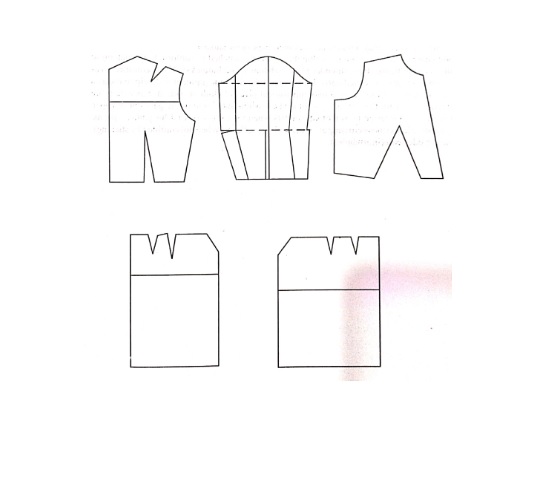Basic pattern parts: - The fundamental components that form the basis of a dress pattern are commonly referred to as basic patterns, blocks, foundations, or slopers. These pattern pieces serve various essential purposes in the pattern making process. Firstly, they aid the pattern maker in comprehending the fit of a garment in relation to the pattern shape during the development phase. Additionally, they serve as a record of the wearer's dimensions, ensuring that the final garment fits correctly.
Furthermore, basic patterns form the foundation of the flat pattern making system, which is a crucial technique used to create various garment designs. They also serve as the basis for other foundational patterns, such as the torso, jacket, coat, jumpsuit, swimwear, and many more. Overall, basic patterns are an integral part of the dressmaking process, and understanding their significance is essential for producing high-quality garments that fit perfectly. Heights Fashion Institute Jaipur provides the best Fashion design courses in Jaipur.
Achieving pattern perfection is crucial for the success of the flat pattern making system, as any errors in the basic patterns can lead to issues in subsequent designs based on them. Therefore, it is essential to invest the necessary time and effort to meticulously analyze the fit of a garment and make any required pattern corrections to achieve pattern perfection.
The process of perfecting the basic patterns is a valuable investment that pays off in the long run. It ensures that the foundational patterns are accurate, and all subsequent designs based on them will fit correctly. Consequently, the time and effort put into achieving pattern perfection is a worthwhile endeavor that results in high-quality garments with impeccable fit and finish.
During the shaping process of pattern making, the dimensions of the figure are represented on the pattern using straight lines, curved lines, and wedge shapes to reflect length, width, and depth. To better visualize this process, imagine a transparent cylindrical wrap around the body.
For the front view, excess fabric beyond the figure's outline, such as the neckline, shoulder, armhole, side, waist, and hipline, is cut away. This creates the outer shape of the pattern.
In the side view, excess fabric remaining within the garment is stitched to conform to the outermost bulges of the figure, such as the bust, shoulder blades, abdomen, and buttocks. These confined areas form wedges, commonly known as darts. Darts play a crucial role in controlling the fit of the garment and creating a three-dimensional form from a two-dimensional piece of cloth or pattern. Heights Fashion Institute Jaipur provides best Fashion Designing in Jaipur.
Since darts are an integral part of fit, they are always present somewhere within the frame of the garment or paper. They may also be referred to as dart equivalents when the excess fabric is used for gathers, pleats, tucks, style lines (those crossing at, or near, a bulge), flare (when not confined by stitching), and hidden ease (in armholes).Overall, the shaping process is a critical step in pattern making that ensures the garment fits the wearer perfectly and achieves the desired three-dimensional shape.
Conclusion:- Heights Jaipur is a leading fashion design institute in Jaipur that offers comprehensive courses for students interested in pursuing a career in the fashion industry. Join us today to turn your creative passion into a successful profession. Heights Jaipur is one of the top fashion colleges in Jaipur, offering a wide range of courses for students interested in pursuing a career in fashion design. With experienced faculty, industry-relevant curriculum, and modern facilities, we provide our students with the best possible education and training. Join us today to unleash your creativity and become a successful fashion designer.





Comments